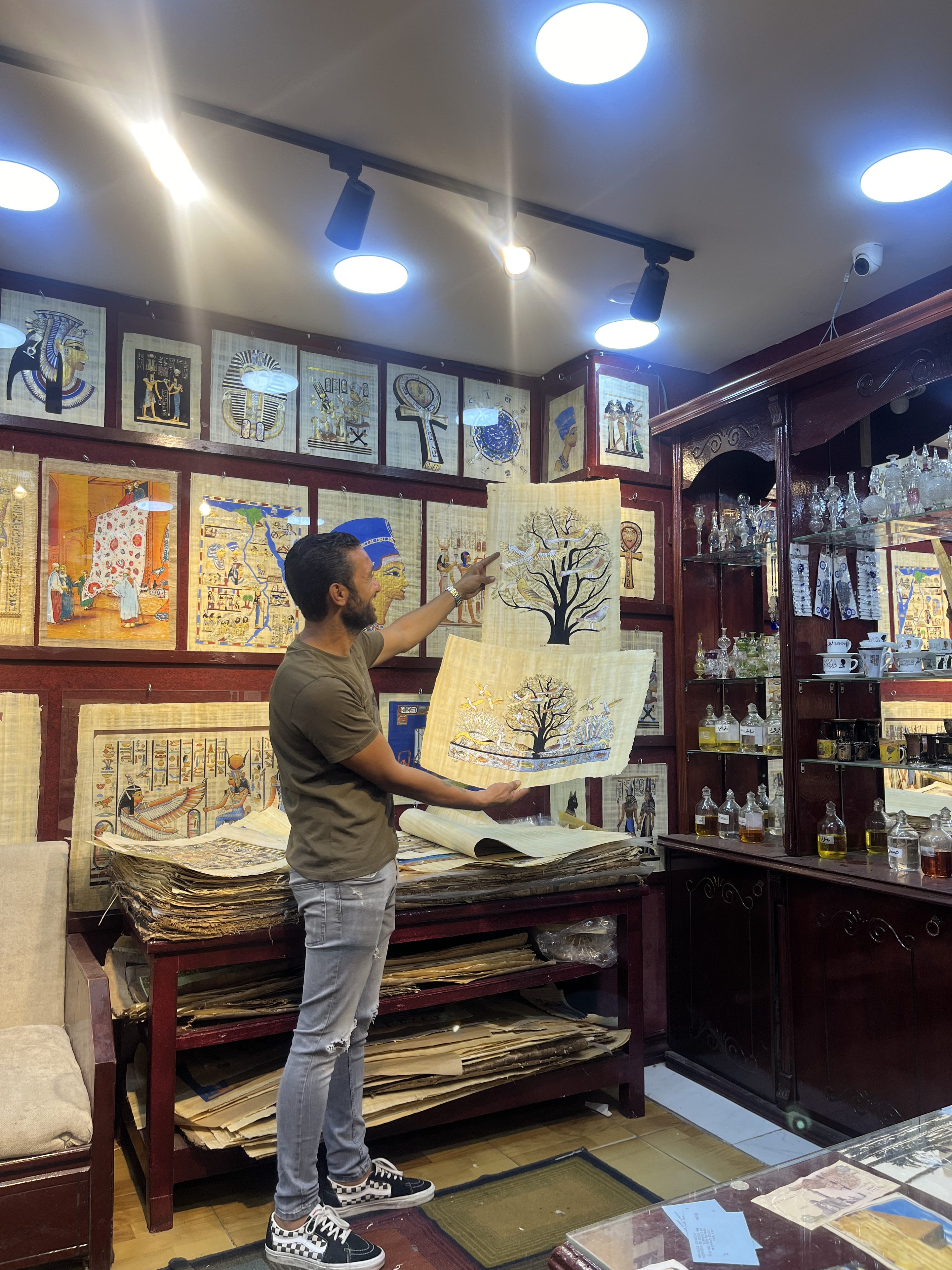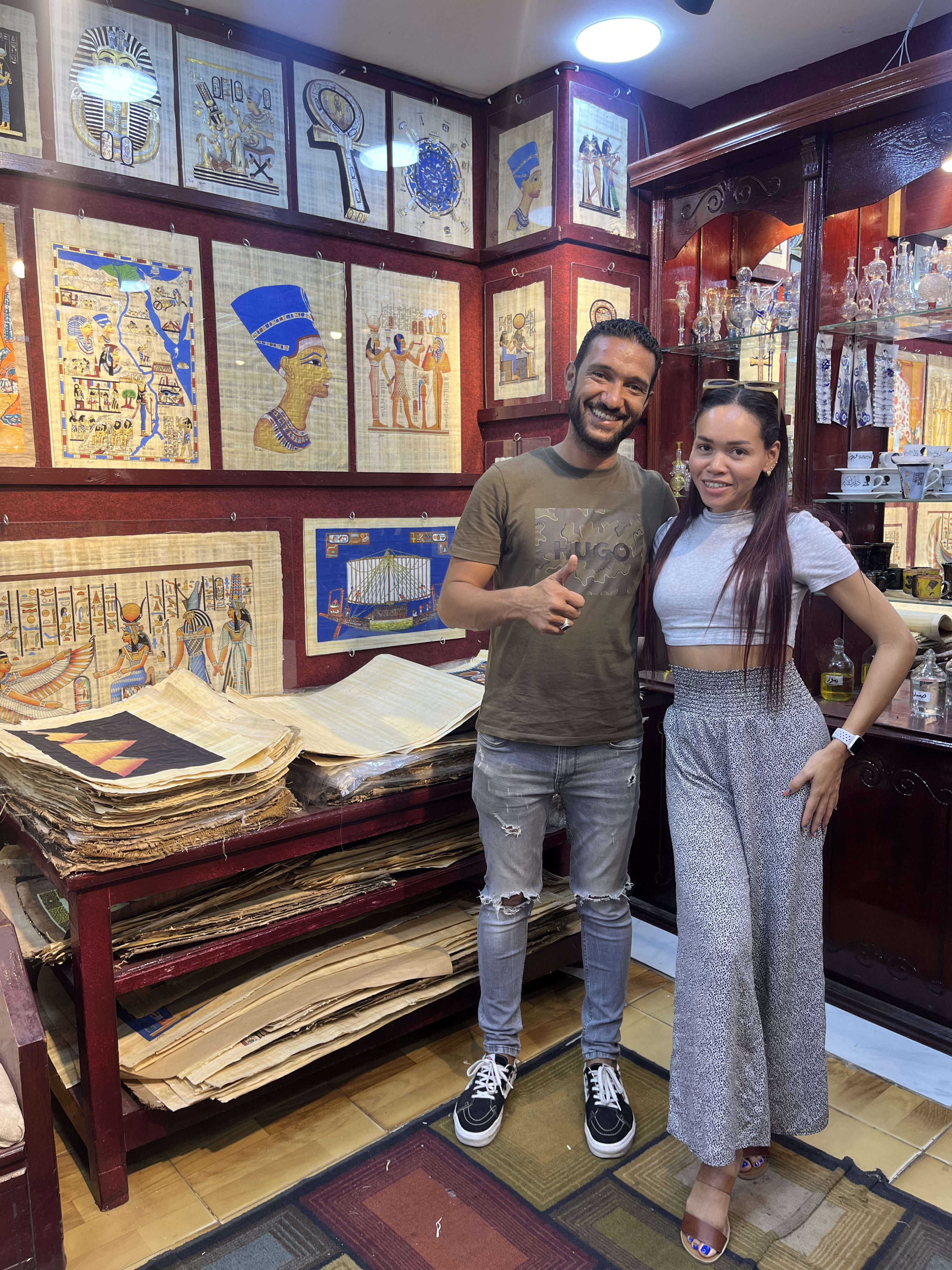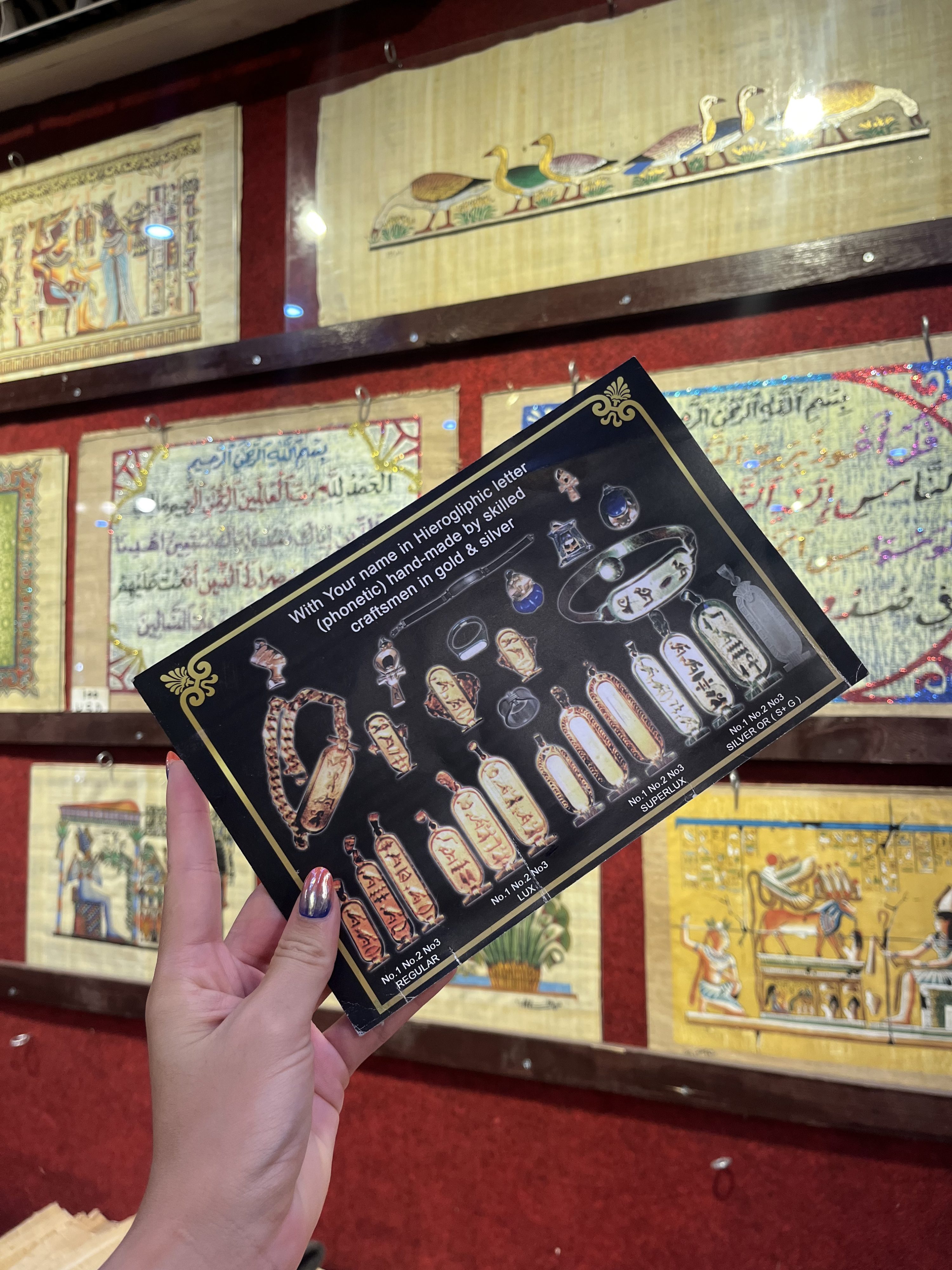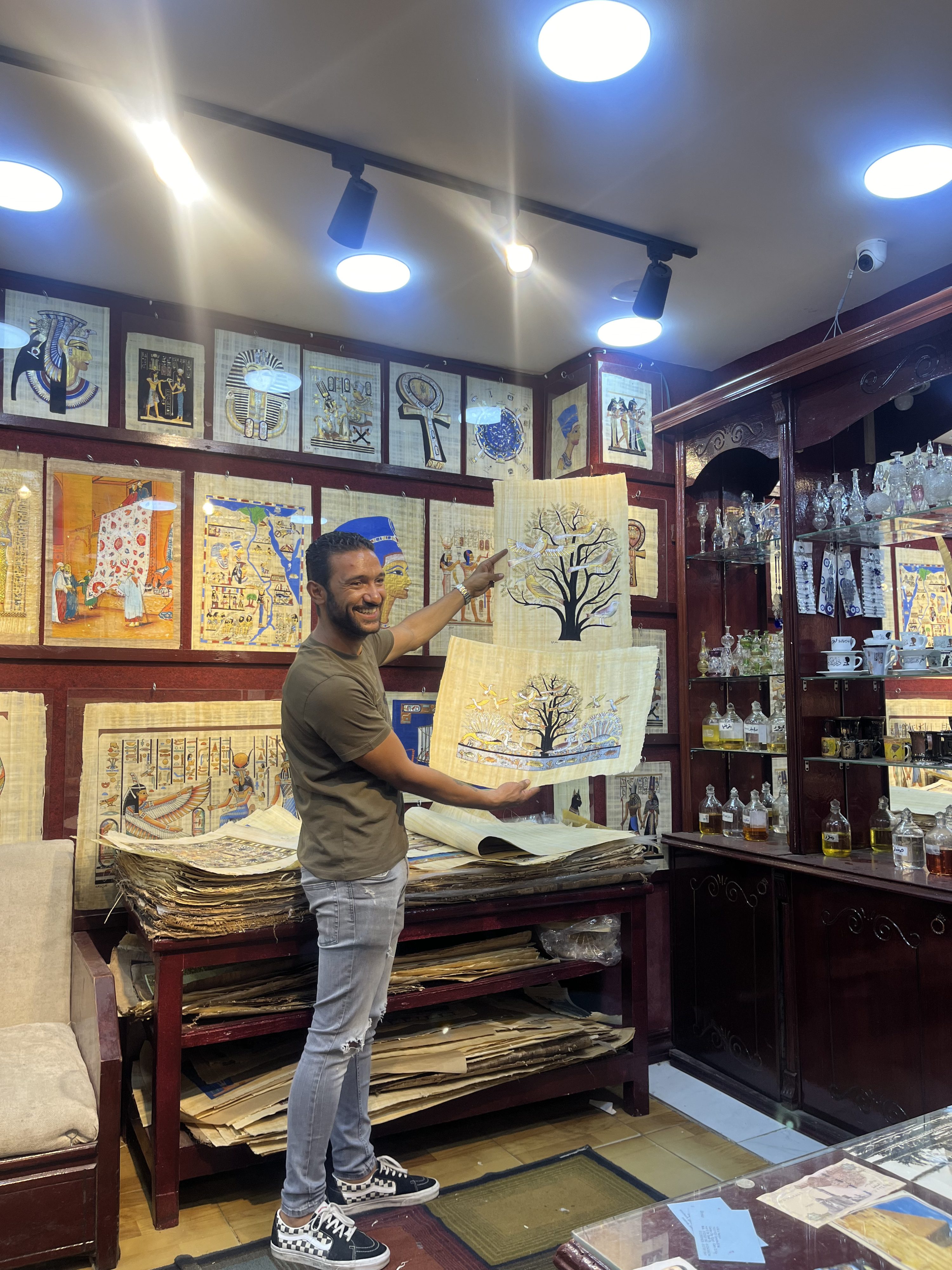Cairo, the bustling heart of Egypt, offers a unique blend of history, culture, and art. Among its many treasures, one stands out as a symbol of Egypt’s rich heritage—the ancient art of papyrus making. Whether you’re an art enthusiast, a history buff, or a traveler looking for the perfect souvenir, understanding the significance of papyrus and knowing where to buy authentic pieces in Cairo will enhance your appreciation for this ancient craft.
In this post, we’ll explore the best places to buy papyrus in Cairo, delve into the intricate art of papyrus making, discuss the importance of authenticity stamps and certificates, and explain why papyrus makes an ideal gift. Additionally, we’ll address the question of whether papyrus is becoming extinct and discuss its enduring value.
Papyrus is not just a material; it’s a symbol of civilization itself. Ancient Egyptians were the first to create a writing surface from the papyrus plant, which grew abundantly along the Nile River. This innovation dates back to as early as 3000 BC, making papyrus one of the oldest writing materials in the world.
The process of making papyrus paper begins with the Cyperus papyrus plant, a tall, reed-like plant that thrives in the marshy areas along the Nile. The plant’s stem is harvested and cut into thin strips, which are then soaked in water to remove the natural sugars. After soaking, the strips are layered in crisscross patterns and pressed together under a heavy weight for several days. The result is a smooth, durable sheet of papyrus that can be used for writing, painting, and even making small artifacts.
What makes papyrus unique is its natural resilience. Unlike modern paper, papyrus doesn’t easily tear, and it has a natural resistance to mold and decay, which is why ancient papyri have survived for thousands of years. The texture of papyrus is distinct, with a natural grain that adds character to any artwork or text.
In ancient Egypt, papyrus was used for everything from religious texts and official documents to artwork and personal letters. The most famous examples of papyrus art include the Book of the Dead, a collection of funerary texts that guided the deceased through the afterlife. These scrolls were often richly decorated with intricate hieroglyphs and vivid illustrations.
Today, the tradition of papyrus art continues in Cairo, where skilled artisans create beautiful hand-painted scenes on papyrus paper. These artworks often depict scenes from ancient Egyptian mythology, such as the gods and goddesses, pharaohs, and daily life along the Nile. The colors are vibrant, and the level of detail is astonishing, making each piece a true work of art.

Finding Authentic Papyrus in Cairo: The Perfect Place to Buy
Cairo is home to numerous papyrus shops, but finding an authentic piece requires a discerning eye and some knowledge about the craft. Many tourists are drawn to the bustling Khan El Khalili market, where you can find a wide variety of souvenirs, including papyrus. However, not all of these pieces are genuine, as some vendors sell replicas made from banana leaves or other materials.
For those seeking authenticity, a visit to the Papyrus Institute or Egyptian Papyrus Museum in Cairo is highly recommended. These institutions are dedicated to preserving the art of papyrus making and offer a wide selection of genuine papyrus artworks. What sets these places apart is their commitment to quality and authenticity. Each piece of papyrus sold here comes with a certificate of authenticity, ensuring that it is made from genuine papyrus plants and crafted by skilled artisans.
Another excellent option is Dr. Ragab’s Papyrus Institute, one of the oldest and most reputable papyrus shops in Cairo. Dr. Ragab, a pioneer in reviving the ancient art of papyrus making, established the institute in the 1960s. Today, it is a popular destination for tourists and art collectors alike. The institute not only sells papyrus art but also offers demonstrations of the papyrus-making process, allowing visitors to witness the craft firsthand.
When purchasing papyrus in Cairo, it’s crucial to look for authenticity stamps or certificates. Genuine papyrus artworks are often stamped with a seal of authenticity, which indicates that the piece was made using traditional methods and from real papyrus plants. This stamp is usually found on the back of the artwork.
In addition to the stamp, reputable sellers will provide a certificate of authenticity, which includes details about the artist, the process used to create the papyrus, and information about the significance of the depicted scene. This certificate not only adds value to the artwork but also serves as a guarantee of its authenticity.
The Value of Papyrus: A Timeless Treasure
Papyrus is more than just a piece of art; it’s a connection to the ancient world and a testament to human ingenuity. The value of papyrus lies in its history, craftsmanship, and cultural significance. Each piece tells a story, whether it’s a depiction of a pharaoh, a scene from daily life, or a representation of an ancient myth.
When visiting Cairo, papyrus makes an ideal gift for several reasons. Firstly, it’s a unique and meaningful souvenir that reflects the rich cultural heritage of Egypt. Unlike mass-produced trinkets, papyrus art is handcrafted and each piece is unique. It’s a gift that conveys thoughtfulness and an appreciation for history and art.
Secondly, papyrus is lightweight and easy to transport, making it a practical choice for travelers. It can be rolled up and placed in a protective tube for safekeeping during your journey. Once home, it can be framed and displayed as a beautiful reminder of your trip to Egypt.
Lastly, papyrus is a versatile gift. It appeals to a wide range of people, from art lovers and history enthusiasts to those who appreciate unique and culturally significant items. Whether given as a decorative piece, a conversation starter, or a cherished keepsake, papyrus is a gift that resonates with everyone.

The Future of Papyrus: Is It Becoming Extinct?
Given the ancient origins of papyrus and the changing environmental and economic landscape, one might wonder whether papyrus is becoming extinct. The answer, fortunately, is no. While the papyrus plant is not as widespread as it once was, efforts to preserve and cultivate it have ensured its survival.
In recent years, there has been a renewed interest in the conservation of the papyrus plant. In Egypt, several initiatives have been launched to protect and cultivate papyrus, particularly in regions where the plant once thrived. These efforts are supported by both the government and private organizations, which recognize the cultural and ecological importance of papyrus.
In addition to conservation, there has been a focus on sustainable harvesting practices. Papyrus is harvested in a way that allows the plant to regenerate, ensuring that it can continue to be used for generations to come. This sustainability is crucial, as it supports the livelihoods of artisans who rely on papyrus-making as a source of income.
Despite the challenges, the art of papyrus making remains alive and well in Cairo. The demand for authentic papyrus art continues to grow, driven by tourists and collectors who appreciate the historical and cultural value of this ancient craft. As long as there is interest in Egypt’s rich history, the tradition of papyrus making will endure.
Moreover, modern technology has allowed for the creation of high-quality reproductions of ancient papyrus texts and artworks. These reproductions, while not made from genuine papyrus, help to keep the imagery and symbolism of ancient Egypt alive and accessible to a broader audience.

Papyrus is more than just a souvenir; it is a symbol of Egypt’s enduring legacy. The ancient craft of papyrus making has survived for millennia, thanks to the dedication of artisans and the ongoing interest in Egypt’s rich cultural heritage. When you purchase a piece of authentic papyrus in Cairo, you are not only acquiring a beautiful work of art but also a piece of history.
Whether you’re visiting the Papyrus Institute, the Egyptian Papyrus Museum, or Dr. Ragab’s Papyrus Institute, you’ll find that the art of papyrus making is alive and well in Cairo. Each piece of papyrus you buy supports local artisans and helps to preserve this ancient craft for future generations.
So, the next time you find yourself in Cairo, take the time to explore the world of papyrus. Discover the perfect piece to take home, and enjoy the knowledge that you’re carrying with you a tangible connection to one of the world’s oldest and most revered civilizations. Papyrus is not just a gift; it’s a lasting legacy, a reminder of the beauty and ingenuity of ancient Egypt, and a timeless treasure that will be cherished for years to come.










